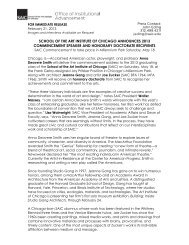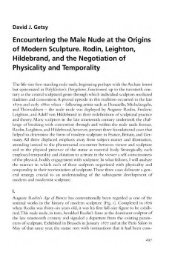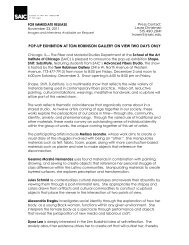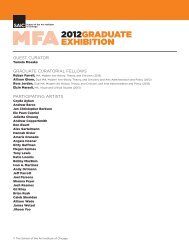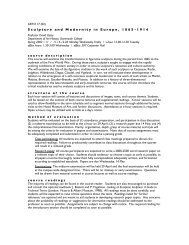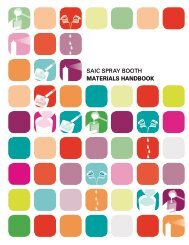i. institutional support and commitment to continuous improvement
i. institutional support and commitment to continuous improvement
i. institutional support and commitment to continuous improvement
You also want an ePaper? Increase the reach of your titles
YUMPU automatically turns print PDFs into web optimized ePapers that Google loves.
School of the Art Institute of Chicago<br />
Department of Architecture, Interior Architecture, <strong>and</strong> Designed Objects<br />
Master of Architecture<br />
Master of Architecture with emphasis in Interior Architecture<br />
the department with several teaching significantly outside the department, three adjunct faculty, <strong>and</strong> 22<br />
part-time faculty. There were 71 BIA students <strong>and</strong> 22 MFA students.<br />
Now nine years later, in 2010 the department has doubled its full-time faculty <strong>to</strong> 14, in addition <strong>to</strong> eight<br />
adjunct faculty, <strong>and</strong> 32 part-time faculty along with four full-time faculty from outside the department<br />
who teach some classes in the MArch program. Comparing student numbers, the BIA program suggests<br />
a nearly 40% increase, with a 50% decrease in MFA students <strong>to</strong> a more selective 11 students, <strong>and</strong> an<br />
overall increase of the graduate population with over 100 graduate students in the department <strong>and</strong> a<br />
<strong>to</strong>tal of 64 Master of Architecture students.<br />
Strengths cited in 2001 included:<br />
o Thriving, rigorous program that would be enhanced with the presence of architecture<br />
o Strong community of faculty, students, <strong>and</strong> alumni<br />
o Positive impact of his<strong>to</strong>ry <strong>and</strong> theory that would continue with new critical studies from<br />
a proposed new design core<br />
o Strong curricular presence of his<strong>to</strong>ric preservation, theory, <strong>and</strong> digital imaging, areas<br />
considered declared weaknesses in competi<strong>to</strong>r programs<br />
Challenges cited in 2001 included curriculum <strong>and</strong> facilities:<br />
2001 Programmatic <strong>and</strong> Curricular Concerns<br />
o Recognition of SAIC as an art <strong>and</strong> design school<br />
o Plan for a three-year architecture program <strong>to</strong> diversify department offerings, <strong>and</strong> clarify<br />
between MFA-tu<strong>to</strong>rial based education <strong>and</strong> professional structured path<br />
o Need for accomplished faculty in designed objects, material research, <strong>and</strong> interior<br />
architecture with achievement in their fields.<br />
o Integration of newer, recent faculty with established, tenured faculty as well as<br />
curricular integration of traditional with digital instruction<br />
o Curricular move from a stylistic, his<strong>to</strong>rical approach emphasizing creativity <strong>to</strong>ward a<br />
more critical, research-oriented program.<br />
2001 Facilities <strong>and</strong> Technology Concerns<br />
o Spatial constraints of classrooms in Sharp building’s 12th floor, already at maximum use<br />
potential, preclude growth <strong>and</strong> cultivation of studio culture; not equipped for wireless<br />
o Urgent need for NT lab, Au<strong>to</strong> CAD classes, <strong>and</strong> Rapid pro<strong>to</strong>typing CNC shop<br />
o Lack of material processes available for studio work<br />
o Lack of raw demonstration <strong>and</strong> assembly space<br />
o Inadequate task lighting for offices <strong>and</strong> studios<br />
In 2001 the dream of a three-year graduate degree or additional space <strong>and</strong> resources seemed speculative.<br />
En route <strong>to</strong> establishing the MArch program, SAIC has met most every challenge of fully <strong>and</strong> profoundly.<br />
Brief descriptions of how challenges were met are included below:<br />
a) Raising the Profile of SAIC as a School of Art <strong>and</strong> Design<br />
The School of the Art Institute of Chicago, celebrated for its #1 ranking in the fine arts, has<br />
strived <strong>to</strong> reposition itself as a school of art <strong>and</strong> design. In addition <strong>to</strong> undergraduate <strong>and</strong><br />
graduate-level program development, several strategies have been developed <strong>to</strong> effect this<br />
change—the formation of an Advisory Design Council comprised of leading design <strong>and</strong><br />
engineering professionals in Chicago; student <strong>and</strong> faculty participation in major national <strong>and</strong><br />
international design expositions; <strong>and</strong> faculty-curated exhibitions <strong>and</strong> lecture series for the public.<br />
Architecture Program Report | 34



